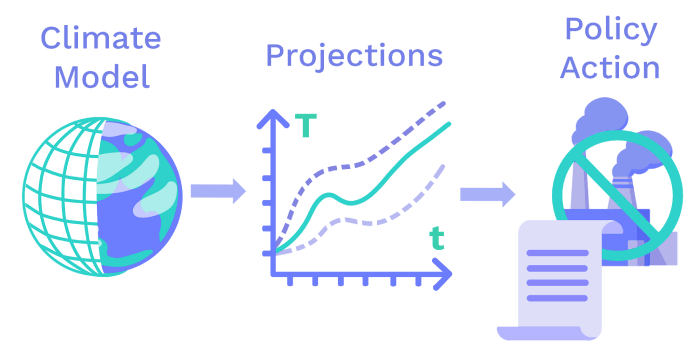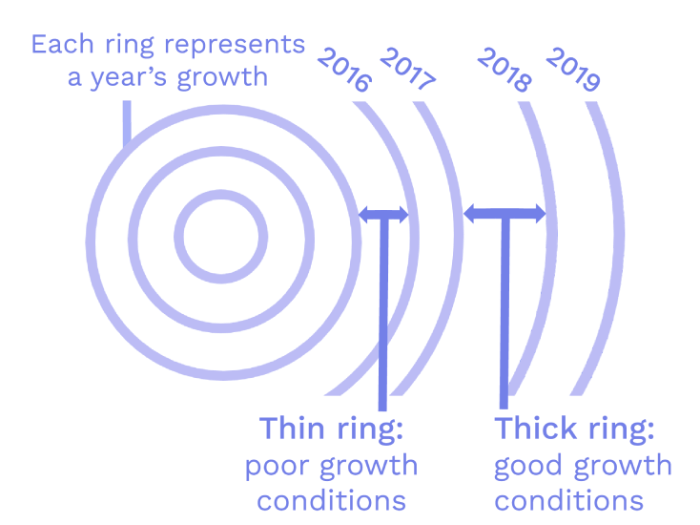Climate Models: How can we predict climate change?
8 minute read
Updated on: 03 Mar 2021
You may have heard a lot about how global temperatures are going to increase dramatically in the near future due to climate change. But how do we know this?
Sorry to all of you car-loving readers but in this chapter we’ll be talking about simulations of the Earth’s climate. That said, it’s pretty cool to be able to make predictions of the future, right?

Predictions to Policy Action
How do climate models allow us to do this?
The climate is a system which involves the atmosphere, oceans, ice, land, and all living things on Earth. Interactions between these different elements mean that the climate system changes all the time
. For example, water that forms rain on land can have evaporated from the ocean
.
The climate can also be forced to change by events that are not part of the natural climate system, such as volcanic eruptions or increased CO₂ emissions
. These are called forcings
.
Climate models make predictions by simulating the interactions between parts of the climate system and external forcings. To do this, scientists must represent these processes using complex scientific equations
. For example, some equations will be based on balancing the energy
from the Sun with the energy absorbed or reflected by the Earth and clouds in the atmosphere
.
However, some processes (such as how a growing tree affects the climate or how clouds form
) are still quite uncertain and have to be approximated by equations
. Records of the climate in the past are then used to improve these approximated equations that predict future climate
.
If a climate model can simulate past climates they are more likely to correctly simulate future climates.
Climate scientists make predictions for future climates using climate models, by putting possible scenarios for amounts of CO₂ emissions and other variables into the equations.
Where do scientists get the data from?
There are many different ways of estimating what the climate was like up to a million years ago
. For example, when scientists look at the cross-section of certain tree trunks they can estimate what the climate was like thousands of years ago
.

Ring width weather estimations
There are many benefits to estimating what the climate was like before 1850. For example, this time period included changes in climate that were much larger and faster
than any in the past 170 years. Using data from such dramatic, rapid changes in past climates can improve predictions for the unusual and extreme climatic changes we are currently facing
.
How do scientists use this data?
Scientists use historic data to test their models. Remember, if a climate model can simulate past climates then it is more likely to correctly simulate future climates
. However, scientists face challenges because using data that isn’t collected directly (scientists weren’t using thermometers to measure air temperatures 500 years ago!) means there is some uncertainty
.
Furthermore, even if historic data is accurate there is always uncertainty about what will happen in the future. Just because a model can make predictions which agree with the historic data, doesn’t automatically mean future predictions will be accurate!
There is also the problem that predictions and simulations of aspects of the climate system will be less reliable if there is not enough data or if the processes are just too complex to represent accurately. This is the case for rainfall, snowfall, deep ocean temperatures and Antarctic sea ice predictions
.
Scientists are constantly working to check and improve
how accurately their models make predictions and a lot of that is based on how well these models would have predicted, say the climate from 1980 until today if they were run in 1980.
Are climate models accurate?
Climate models have been used to make accurate predictions for the past 50 years and have advanced significantly during this time
. For example, the models used in a scientific report written by thousands of scientists in 2013 replicated the actual global surface temperatures experienced with a 99% success rate
!
Models can never be 100% accurate. For this to happen scientists would need to understand and simulate every aspect of the climate system
and know exactly how each and every one of us would act in the future. Without a crystal ball, this is clearly quite difficult
!
If climate models aren’t 100% accurate, why do we need them?
Despite some uncertainty in climate model predictions, they are still extremely useful. A key point to realise is that climate scientists don’t need to predict the future to help policymakers; by using several different well-considered scenarios of human responses to climate change (from doing nothing to doing a huge amount) climate modellers can give policymakers an idea of the range of possible changes in climate resulting from different policy actions
.
Therefore climate models can inform policymakers with information and evidence to start making well-informed decisions about future environmental actions. For example, greenhouse gas emissions will increase future temperatures and affect future weather patterns
. Models can be used to predict how human activities, such as increased emissions, will affect the climate
and how quickly CO₂ emissions need to decrease to limit warming to specific levels
, for example the key limit of 1.5°C.
They can also highlight delayed effects – i.e even if we were to stop releasing emissions today, the greenhouse gases that we have already released will continue to cause warming for at least several decades
.
Conclusion
All climate models have limitations but, properly used, they can make important contributions to tackling climate change.
Next Chapter



